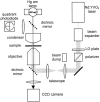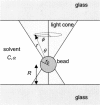Laser-induced heating in optical traps
- PMID: 12547811
- PMCID: PMC1302707
- DOI: 10.1016/S0006-3495(03)74946-7
Laser-induced heating in optical traps
Abstract
In an optical tweezers experiment intense laser light is tightly focused to intensities of MW/cm(2) in order to apply forces to submicron particles or to measure mechanical properties of macromolecules. It is important to quantify potentially harmful or misleading heating effects due to the high light intensities in biophysical experiments. We present a model that incorporates the geometry of the experiment in a physically correct manner, including heat generation by light absorption in the neighborhood of the focus, balanced by outward heat flow, and heat sinking by the glass surfaces of the sample chamber. This is in contrast to the earlier simple models assuming heat generation in the trapped particle only. We find that in the most common experimental circumstances, using micron-sized polystyrene or silica beads, absorption of the laser light in the solvent around the trapped particle, not in the particle itself, is the most important contribution to heating. To validate our model we measured the spectrum of the Brownian motion of trapped beads in water and in glycerol as a function of the trapping laser intensity. Heating both increases the thermal motion of the bead and decreases the viscosity of the medium. We measured that the temperature in the focus increased by 34.2 +/- 0.1 K/W with 1064-nm laser light for 2200-nm-diameter polystyrene beads in glycerol, 43.8 +/- 2.2 K/W for 840-nm polystyrene beads in glycerol, 41.1 +/- 0.7 K/W for 502-nm polystyrene beads in glycerol, and 7.7 +/- 1.2 K/W for 500-nm silica beads and 8.1 +/- 2.1 K/W for 444-nm silica beads in water. Furthermore, we observed that in glycerol the heating effect increased when the bead was trapped further away from the cover glass/glycerol interface as predicted by the model. We show that even though the heating effect in water is rather small it can have non-negligible effects on trap calibration in typical biophysical experimental circumstances and should be taken into consideration when laser powers of more than 100 mW are used.
Figures













References
-
- Ashkin, A., J. M. Dziedzic, and T. Yamane. 1987. Optical trapping and manipulation of single cells using infrared laser beams. Nature. 330:769–771. - PubMed
-
- Block, S. M. 1990. Optical tweezers: a new tool for biophysics. In Noninvasive Techniques in Cell Biology. S. Grinstein, K. Foskett, editors. Wiley-Liss, New York, New York. 375–401.
-
- Daubert, T. E., and R. P. Danner. 1989. Physical and Thermodynamic Properties of Pure Chemicals: Data Compilation. Hemisphere Pub. Corp., New York, New York.
Publication types
MeSH terms
Substances
LinkOut - more resources
Full Text Sources
Other Literature Sources

